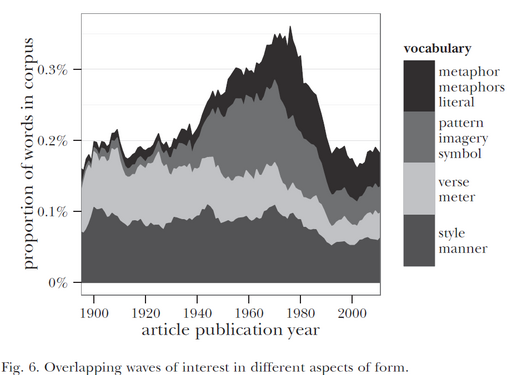Critical Writing
Introduction
Literary criticism is unique in using the same medium as its object, and thus it may be possible to analyse it with the same tools as are applied to literature. There is a lot to learn about the discourses and interests of critical writing through a data-oriented approach that could help to qualify critical writing, particularly in locating the origins and impact of certain concepts, such as feminism or deconstruction, or the canonical status of writers, as it has evolved over time.
But being better informed is just one aspect of critical writing’s engagement with digital approaches. New data-driven methods also change writing by visualising the data (as is evident in the illustration to this companion). This places new demands on writers: does the audience understand the visualisation? Does it avoid seducing us with particular, cherry-picked trends? Are the methods and data sufficiently identified?
When used well, visualising data does two things: it convincingly represents data when there are concrete trends, and it also enables the reader to engage with data and, for example, pay attention to single outliers and temporary drops or spikes. Again, visualisations may be seductive, and the critic’s role should be to convince and to determine how the bread and butter of critical activity—words—and visualisations may play together.
Applications
Elementary
Approaching critical writing can be twofold. On one hand, you can apply digital tools when critically assessing and evaluating the works of others. You can for instance study keywords in selected critical writing using Voyant’s Key Word In Context (KWIC) concordance function which allows you to investigate co-occurrences of words in one or several texts. Another approach is to explore the contexts in which different writers appear and how they relate to each other using tools such as Google Scholar, Google Ngrams, Connected Papers, or The Open Syllabus Galaxy. The Open Syllabus Galaxy is an online tool providing a visualisation of citations based on a database of 7,292,573 college course syllabi and can serve as a useful tool in studying canon formation, both literary and critical.
On the other hand, critical writing can also imply approaching yourself as a writer. A useful feedback tool that can be accessed directly in your browser is The Writer’s Diet, an algorithm-based diagnostic tool developed by Helen Sword. The online tool allows you to enter a text sample between 100-1000 words and returns an automated feedback of your text that, if used intelligently, can help you sharpen and adjust your writing to become more clear, engaging, and effective. The tool also exists in a downloadable version called The Writer’s Diet add-in for MS Word which is capable of analysing Word documents of any length.
Advanced
In digital literature analysis, where reading the whole corpus is simply impossible and findings are based on quantitative data, the role of visualisations is evermore important. When produced correctly, they are an excellent way of communicating the findings to readers. Although there exist numerous programs that allow you to make data visualisations, learning to manipulate and visualise your data by programming expands your possibilities to explore and understand your data. R is an extensive and freely available programming language for data analysis, and the package ggplot is versatile for producing graphs. Kieran Healy’s book Data Visualization. A Practical Introduction (2018) is a comprehensive guide that also demonstrates why data visualisations are important.
Practice your visualisation skills with data you collected when going through other chapters of this website. If you are in doubt about what kind of plot to produce, data-to-viz helps you find the appropriate visualisation format. You can find examples of numerous graphs in the R Graph Gallery.
Digital sphere has also expanded the nature and the study of the nature of literary criticism (see e.g. Goldstone, Andrew, and Underwood, 2014; Winiecka, 2020), and data mining offers a new approach, for example in studying the canon emergence from literary critic texts. For instance, the references to authors can work as an indicator for canonical authors. Following the methods of Ferrer (2013), gather your own corpus of references on a country or genre of your choice and visualise the development of the literary canon. Do you agree with the quantitative findings?
Resources
Scripts and sites
-
Google Books NGram Viewer, an online search engine that plots the frequencies of any set of search strings as n-grams.
-
A plot of most frequently assigned texts on Open Syllabus as a navigator to what is addressed when critically studying literature.
-
R Graph Gallery, R chart examples with code.
-
From Data to Viz, a guide for producing the right kinds of graphs from your data.
-
Connected Papers, a visual tool for exploring relevant papers in connection to each other.
- Writer’s Diet, a diagnostic tool for academic writers.
Articles
-
Younis, E. (2020). New horizons of digital literary criticism. Digital Scholarship in the Humanities. https://academic.oup.com/dsh/advance-article-abstract/doi/10.1093/llc/fqaa026/5847951
- Ferrer, C. (2013). Canonical values vs. the Law of large numbers: The Canadian Literary Canon in the Age of Big Data. Rupkatha, 5(3). http://rupkatha.com/canadian-literary-canon/
-
Goldstone, A., & Underwood, T. (2014). The quiet transformations of literary studies: What thirteen thousand scholars could tell us. New Literary History, 45(3), 359-384. http://dx.doi.org/10.1353/nlh.2014.0025
-
Healy, K. (2018) Data Visualization: A Practical Introduction. Princeton; Oxford: Princeton University Press. https://socviz.co/
-
Moretti, F., & Sobchuk, O. (2019). Hidden in Plain Sight: Data Visualization in the Humanities. New Left Review, 118, 86-115. https://newleftreview.org/issues/ii118/articles/franco-moretti-oleg-sobchuk-hidden-in-plain-sight
-
Winiecka, E. (2020). Literary Internet: Online Criticism and Literary Communication. Porównania, 27(2), 289-311. https://doi.org/10.14746/por.2020.2.15
